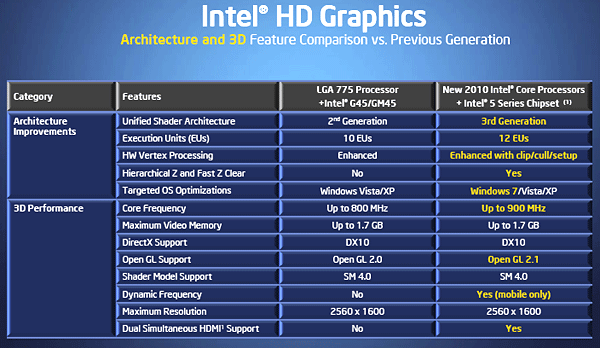
There is little question that Intel's previous generation integrated graphics core left more than a little to be desired, when it came to offloading the CPU of multimedia and gaming tasks. In fact, gaming on an Intel IGP has been historically pretty much non-existent, unless Dora the Explorer online was your kind of thing. It was only recently that Intel began offering a solid HD video experience on with their G45 series chipset and even then, you needed decent processor helping with some of the heavy lifting. However, for this iteration of integrated graphics solutions, if Intel was going to bolt this technology directly to the CPU on the same substrate, they had to beef things up a bit and indeed they have.

Culled from Intel's slide deck, above is a comparison of Intel's previous generation graphics solution that resides on their G45 series chipset, versus the new graphics core that Intel is now calling "GMA HD" and that resides on the CPU package itself. Intel has added an additional pair of engines or execution units as they call them, to the solution, in conjunction with some fairly major upgrades to the architecture. Techniques and algorithms like Hierarchical Z-Buffer and Fast Z clear have been incorporated in competitive discrete GPU solutions from AMD and NVIDIA for many years now but are just making their way into Intel's IGP (Integrated Graphics Processor) solutions. Specifically, these two features afford the GPU core more efficient operation in the rendering pipeline, allowing pixels that aren't needed to be cast out of the rendering workload early, in addition to clearing buffer memory more quickly for faster read/write operations.
The GPU core clock has also been turned up to 900MHz with dynamic clock gating support or "graphics turbo" that, like the processor core itself, allows clock speeds to be ramped up or down based on workload. Finally, Intel has also added dual simultaneous HDMI output support for the platform as well.

There is also a buffed out the feature stack with GMA HD, with respect to HD video processing. The solution now offers dual video decode for picture-in-picture TV tuners and other applications, along with higher 12-bit per component color depth in support of the full HDMI 1.3 specification. DisplayPort support has also been dropped in, in addition to Dolby TrueHD and DTS-HD audio.
All told the enhancements to the graphics and media capabilities of Intel's HD Graphics solution are significant and bring a very much welcomed new level of functionality to the engine that previously Intel simply didn't compete well in versus competitive IGPs on the market. As you saw in our previous video demo of the product, Intel's capabilities have vastly improved in this area. And of course, we'll also chart out some of the hard benchmark data for you on this, in the pages ahead.









